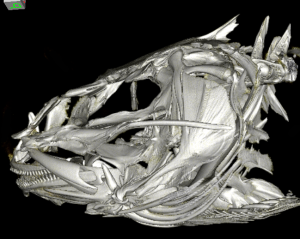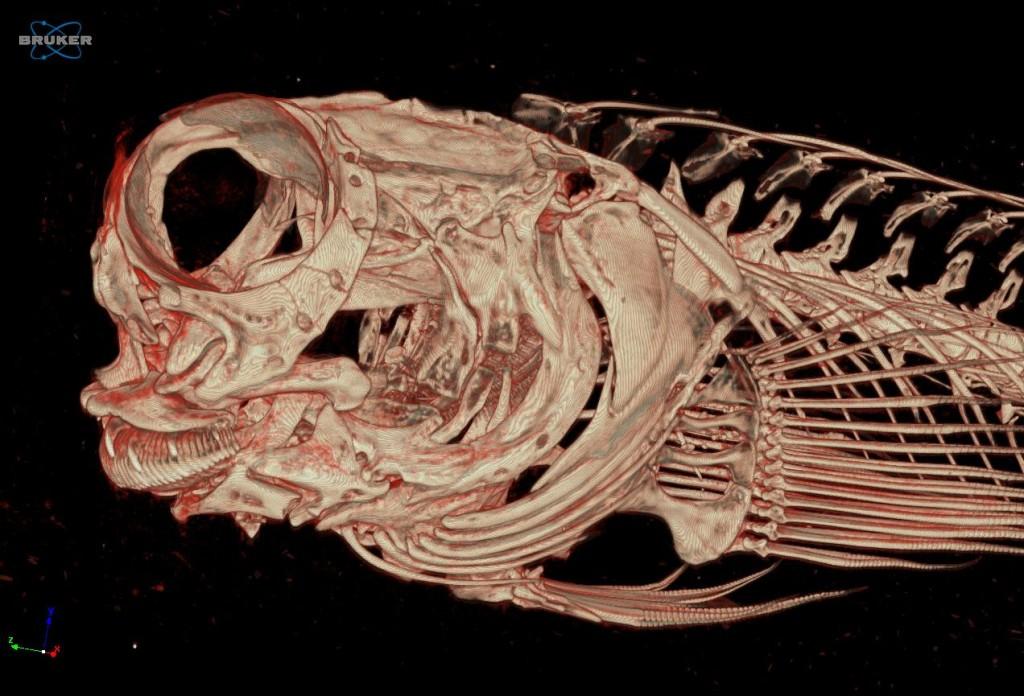If you’ve ever stood on the shore of the ocean, especially at high tide, you may have noticed each wave carrying in an assortment of glittering fishes. Silver or white, translucent or iridescent, the variety is endless, and, unless you’re a marine biologist or fish expert, it’s unlikely that you’ve been able to identify them all, or even any of them. There are somewhere around 30,000 different types of fish on the planet, at an estimate. I can identify a few of them, but my fish ID skills are pretty limited. I’m not too ashamed of this, as even scientists who have studied fish for their entire careers have difficulty telling many species apart.
Adam Summers is a professor of comparative biomechanics at the University of Washington’s Friday Harbor Laboratories, and his goal is to create a visual catalog of as many fish species as possible, so that anyone who cares to can examine them closely.
“I’m using a CT scanner that allows you to visualize 3-D skeletal maps,” he said. “You see fine detail that’s incredibly important for telling one fish from another.”
So far, he has scanned about 40 fish species and uploaded them to his page on the Open Science Framework site. He’s got a long way to go to get to 30,000, but his ambition is high – he intends to “scan ALL the fishes.” The project is multipurpose. Many species of fish, particularly those in the same family, look so similar that it’s nearly impossible to tell them apart, but by studying their skeletal forms, you can see subtle differences in structure that may not seem important, but actually show major differences in how the fishes interact with their environment.
For example, there’s the clingfish family. The family includes over 150 different species, and they all, as their name suggests, cling to things. What they cling to depends on the structure of their pelvic fins, and by studying those structures, Summers can ascertain whether they are a type that clings to rocks, or urchins, or other fish. This is valuable knowledge from a research standpoint alone, but Summers and his colleagues are also interested in studying the structure and behavior of fish to potentially develop new technology.“I look for how fish stick to things, fish that burrow, and fish that wear armor,” he said. “…By scanning the clingfish, you can see performance on all different size structures.”
The open source format of his study is a great way for anyone studying marine biology to augment their research, but it’s also a wonderful resource for kids and adults alike to broaden their knowledge of species diversity. Even those with little or no knowledge of fish can learn a lot – or, if nothing else, one can have a great time imagining a hilarious fish name-calling fight. (“Who are you callin’ a slimy sculpin, you fourfingered lipsucker?!”)
Summers has also been using a 3D printer to create enlarged printed models of his tiny fishes. It’s hard to study detail in something so small, but with a 3D printer, it’s easy to scale something up from a scan so that it can be easily examined. Many scientists have been using this method to study tiny fossils and other microscopic specimens; it’s also a great way to study artifacts without risking damage to the fragile originals.
Still not convinced of the relevancy of Summers’ work to your own interests? I’m willing to bet you’ve seen Finding Nemo. The movement and biology of the fish and other marine animals in the film were largely influenced by Summers, who was contacted by Pixar while working as a Miller Research Fellow at the University of California, Berkeley. He spent three years working as an advisor on the film; without his research, you may never have known how well a fish with a gimpy fin can actually swim (and just keep swimming). What do you think of this endeavor? Discuss in the 3D Fish Species Database forum over at 3DPB.com.
[Source: Wired Magazine]Subscribe to Our Email Newsletter
Stay up-to-date on all the latest news from the 3D printing industry and receive information and offers from third party vendors.
You May Also Like
High Stakes, High Speed: KVG Acquires 15 Nexa3D HSE 3D Printers to Boost Military Tech
As 3D printing increasingly intersects with defense and military logistics, a new partnership between Nexa3D and mission support logistics firm KVG stresses the growing importance of this technology in strategic...
3D Printing Webinar and Event Roundup: April 28, 2024
In this week’s 3D Printing Webinar and Event Roundup, the Ceramics Expo is taking place in Michigan, Stratasys continues its advanced training courses, and SPE is holding a Polymer Characterization...
Attending the ASTM F42/ISO TC 261 Meetings: The Nitty-Gritty of Additive Manufacturing
I never thought I’d be so excited about an event focused on additive manufacturing (AM) standards, but here we are! When I learned that the recent biannual ASTM F42/ISO TC...
World’s Largest Polymer 3D Printer Unveiled by UMaine: Houses, Tools, Boats to Come
The University of Maine has once again broken its own record by unveiling the largest polymer 3D printer in the world. Surpassing its 2019 achievement, the new Factory of the...




![Northern clingfish [Image: Petra Ditsche, University of Washington]](https://3dprint.com/wp-content/uploads/2016/02/clingfish-3-375x224.jpg)






























